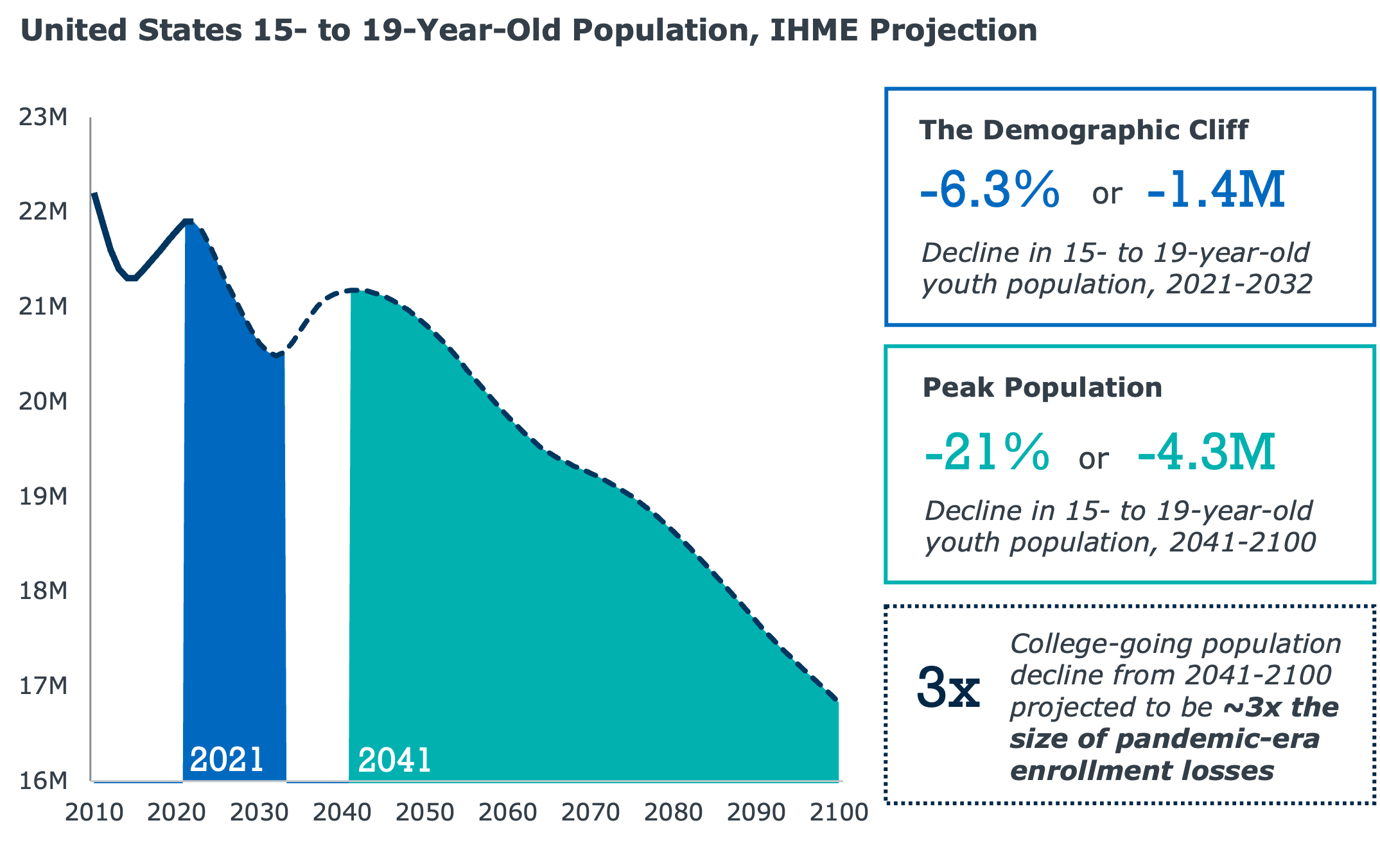3 demographic trends shaping the future of graduate and adult enrollment
You’ve spent years building graduate and adult enrollment pipelines. But now, the terrain is shifting fast. Fewer prospective students, increased scrutiny on the value of higher ed, and concerns about international student pipelines are all making graduate enrollment management more challenging and less predictable.
Here’s a closer look at the demographic trends shaping graduate and adult enrollment and the strategic actions graduate enrollment leaders can take now to best position their institutions in the short and long term.
1. Fewer people means fewer students
The long-anticipated “demographic cliff”—the projected drop-off in college-age individuals due to lower birth rates during the Great Recession—is now a pressing reality. The 15- to 19-year-old population is expected to decline 6% from 2021 to 2032, with states such as California, Illinois, and New York hit the hardest.
But what comes after the demographic cliff is even more concerning. As you can see from the chart below, the Institute for Health Metrics and Evaluation projects we’ll see a much steeper decline (21%) in 15- to 19-year-olds from 2041 to 2100. This means there will be 4.3 million fewer prospective students in this age group, equivalent to three times the enrollment loss experienced during the pandemic.

Implications for graduate enrollment strategy
After more than three decades in higher ed, I’m hoping to have retired to a Caribbean island by the time steep declines hit graduate enrollment in 2041. But the decisions we make on our campuses right now can help mitigate the impacts of demographic decline on our schools’ future. One of the best things we can do to attract today’s and tomorrow’s students is to ensure that our academic programs are aligned with current and projected industry needs. And with fewer students in the market, it’s critical to consider ways you can reach new pockets of students beyond your primary recruitment area. Of course, you can’t overlook your current students. How can you best support them now, both to help them achieve their ideal program outcomes and to set them up as ambassadors for your program—or potentially, future students should they choose to pursue further education?
2. More students are opting out of higher education
High school graduation rates have increased 3.3% across the last decade. But college enrollment has not followed suit. While we expected to see about 276,000 fewer college students due to population shifts, we instead saw a more precipitous drop of 708,000 students, indicating that high school grads who are otherwise well-positioned to go to college are choosing not to enroll.
This rise in non-consumption is partially due to declining confidence in higher education (and U.S. institutions generally). In 2004, about 45% of respondents to a Gallup survey had quite a lot or a great deal of confidence in higher ed. Now, this number hovers around 28%. At a time when higher ed is in the media spotlight, and parents and students are questioning the value of an advanced degree, it’s more important than ever to highlight program value.
Download Our Step-by-Step Guide for Creating a Value Proposition for Your Grad Program
Implications for graduate enrollment strategy
Today’s students approach higher education as investors seeking tangible returns. And they are voting with their feet. Undergrad enrollment in industry-aligned programs like health sciences and business management is on the rise, and enrollment at polytechnic institutions with practical training and strong industry partnerships is outpacing enrollment at large publics. These trends signal that students are prioritizing programs that lead to stable, well-paying jobs.
At the same time, our annual surveys of prospective graduate students consistently show that students most often “opt out” due to the high cost of attendance. Ensure you clearly communicate how your program delivers a quantifiable return on investment. For example, how has your program impacted alumni career transitions and earning potential? How can you tell a story about your program’s impact on students’ life success? And is information about tuition and fees presented clearly and prominently on your program pages?
3. International markets are less reliable
Population decline isn’t limited to the U.S. Countries such as Japan and China have already hit peak population. Germany and India are not far behind; they are expected to hit peak population in 2035 and 2046, respectively.
But perhaps what’s most pressing for enrollment leaders is the impact of federal policy on international enrollment. Headlines about visa delays or revocations, international student detainments, and travel bans can all impact student interest in studying in the U.S. A Studyportals survey from earlier this year shows a 40% decline in international student interest in U.S. programs.
Explore the Latest Federal Policies Impacting International Enrollment
We’re already seeing signals that enrollment from India, China, and South Korea—the current top three source countries—will wane. And full, partial, or proposed travel bans on countries affecting countries like Afghanistan and Venezuela will also hurt enrollment.
Implications for graduate enrollment strategy
Even institutions that don’t rely heavily on international enrollment will feel the ripple effects. Competitors facing international enrollment declines may intensify efforts to attract domestic students, increasing competition in an already crowded market. It’s critical for institutions of all kinds to strengthen or develop robust domestic enrollment strategies to remain competitive.
It’s also important to consider how changes to international enrollment will impact specific disciplines. We know that STEM-designated programs like math, computer science, and engineering often attract international students due to both personal interest in these areas and longer OPT options. Consider ways you can bolster recruitment efforts for high-potential STEM programs.
With fewer potential students in the market, graduate and adult enrollment leaders have the chance to rethink how they convey program value and nurture prospects who express interest in their programs. The institutions that succeed despite these headwinds will be those that innovate and plan, not just react.

More Blogs

What enrollment leaders can learn from Alabama’s statewide direct admissions program

4 questions domestic students will ask before applying to your graduate program
